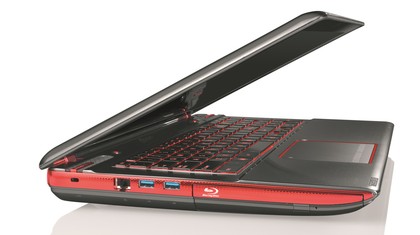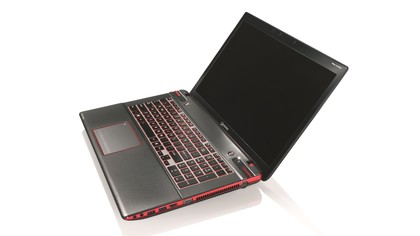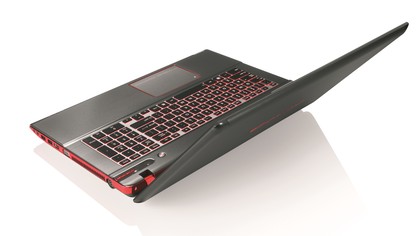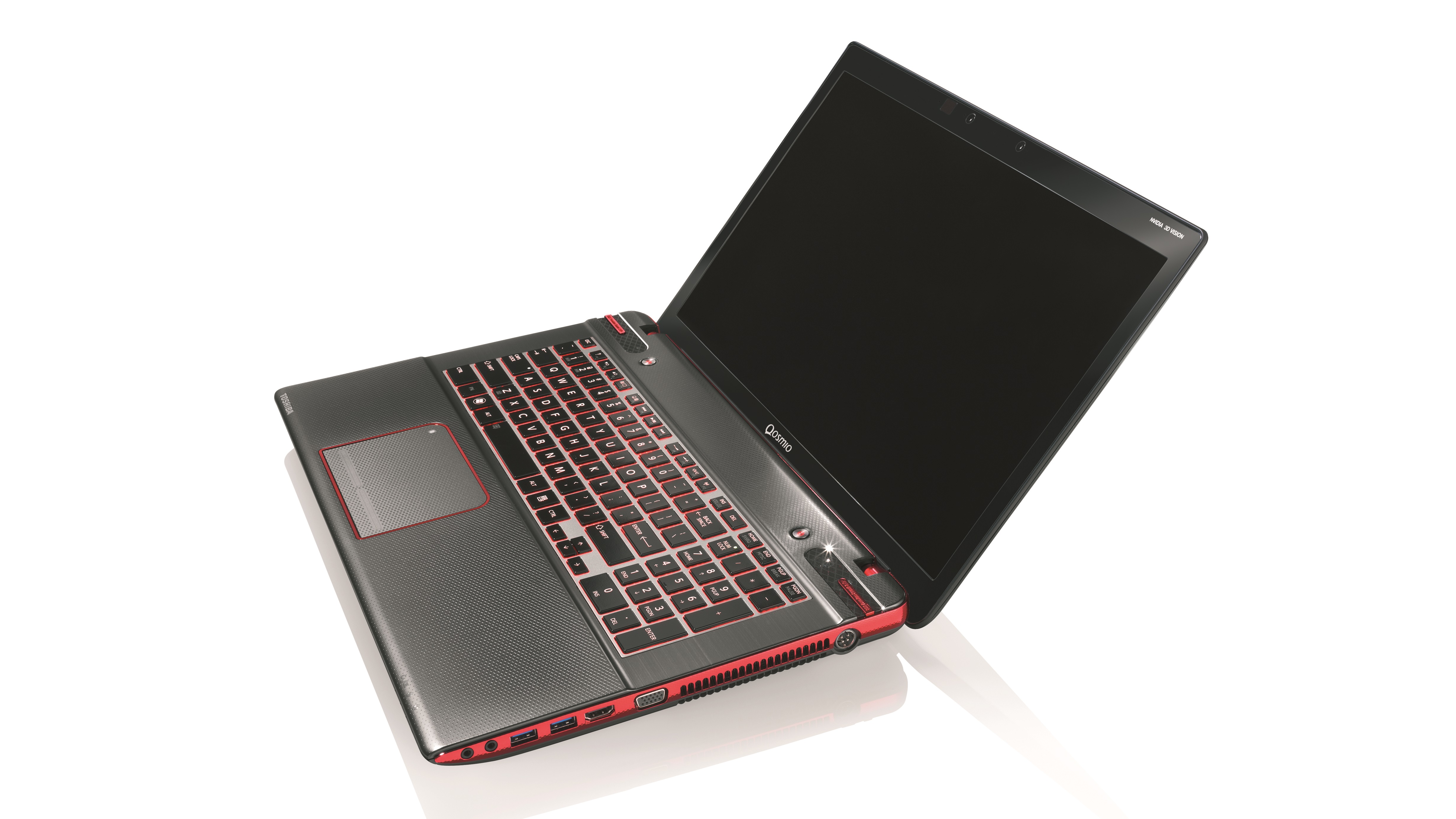TechRadar Verdict
Pros
- +
Extremely powerful
- +
3D screen
- +
Great connectivity
- +
Blu-ray
- +
Interesting design
Cons
- -
Rather expensive
- -
Zero portability
- -
No battery life
- -
Wonky DC cable
- -
Average keyboard
Why you can trust TechRadar
Spearheading the Ivy Bridge refresh for Toshiba is the 3D-toting gaming giant known as the Qosmio X870 ($1,899).
From the black and chrome-red chassis to the bleeding edge components inside, this is a laptop designed specifically to take on the 3D-ready Samsung Series 7 Gamer and the might of the Alienware M17X.
Its mission is to simply cater to power hungry gamers looking for the best machine to handle 2012's latest titles.
We use the word giant with good reason; the X870's chassis is a huge 418 x 272 x 44mm and weighs an impressive 3.4kg.
The design follows a head-turning trend with a black plastic body trimmed with shiny red chrome.

In a world of sleek, silver machines, like the new MacBook Air or the Dell XPS 14, the Qosmio embraces the outlandish design we've come to expect from the gaming laptop stable.
We have no doubt that the Qosmio X870 could run any game under the sun thanks to the combined power of the Intel Core i7-3610QM CPU, clocked at 2.3GHz and the Nvidia GeForce GTX 670M graphics card.
Meanwhile all the extra features we would expect from a laptop at this price are here in force.
The Toshiba Qosmio X870 boasts 4 USB 3.0 ports, a Blu-ray drive, HDD protection, harmon/kardon speakers, a backlit keyboard and, of course, that all-important 3D screen.
And yet, for all its dominance when it comes to performance, there are a couple of slight hiccups that cause us to question whether this is The Greatest Gaming Machine Ever™ or just a very, very good challenger to the all-conquering Alienware series.
Specifications
There's no compromise on specifications here.
Toshiba has kitted the Qosmio X870 out with an Intel Ivy Bridge Core i7-3610QM CPU with a speed of 2.3GHz that can be overclocked to 3.3GHz.
On top of that the Nvidia GeForce GTX 670M graphics card will give you 3GB of dedicated video memory on top of the 3GB already provided by the integrated Intel HD Graphics 4000 chip.
Moreover, there's a massive 16GB of RAM keeping the operation as smooth as possible.
And, because the native resolution is a pin-sharp 1,920 x 1,080, you'll be able to enjoy all your gaming in Full 1080p High Definition. The way that nature intended.
Alongside the Full HD resolution, the 17.3-inch screen on the Toshiba Qosmio X870 is also extremely bright.

This is a good thing - as the bundled Nvidia active shutter glasses that you'll need for 3D will shade the display dramatically.
The stereoscopic 3D works well and the Nvidia Control Panel will give you a list of compatible games and how well those titles work with the 3D technology.
The only drawback is that the thick plastic glasses look like something Michael Caine would pull on back in his Harry Palmerdays.
We know that 3D glasses can be lightweight and look good, because we've seen Samsung do it with the Series 7 Gamer.
Don't worry about the space required for high definition or 3D media, the Qosmio X870 has a terabyte of hard-drive space, giving you plenty of digital real estate for media and games.
Toshiba has also built in HDD protection, so when vibration or a drop is detected; the X870 shifts the position of the drive to keep your valuable data safely protected.
All four USB ports are the faster USB 3.0 format which gives you data transfer speeds of up to 5Gbps. So, should you decide to invest in some external storage or a few extra peripherals to accessorise the Qosmio X870, you won't be left waiting around.
The rest of the connections read as standard, HDMI and VGA for connecting extra monitors and a Gigabit Ethernet port in case you don't want to use the 802.11n wireless connection.
The optical drive on the Qosmio X870 is a Blu-ray, doubling this laptop as an extra Blu-ray player for your home and you also get the benefit of sleep-and-charge.
When the Qosmio X870 is in sleep mode or even shut down completely, you can use it to charge your smartphone or tablet.
Performance
Cinebench 10: 21,197
3D Mark '06: 10,772
Battery Eater '05: 41 minutes
The build quality of a gaming machine is vital – the laptop needs to stand up to some serious hammering during that final boss battle or tense shootout.
Happily, the Qosmio X870 stood up well to our repeated pokes and prods.
There's no getting away from the design though, and we feel it will divide opinion.
On one hand, it's not as outrageous as, say the Alienware or MSI gaming laptops, but it's also not as conservative as the likes of the Medion Erazer X6819 or the Samsung Series 7 Gamer.
Strangely, for a machine with as much chassis real estate as the Qosmio X870, the travel on the keys is relatively shallow.
We'd be expecting keys similar to the HP Envy series, with a reassuring depth to them that could take a pounding during those aforementioned boss battles.
Instead, it's almost as if the keyboard was taken from a space-conscious Ultrabook.
Despite the lack of depth, the Qosmio X870 was comfortable to type on and there's a good amount of space between the keys.
Admittedly, the blood-red backlight behind the keys does look great.
You're also given a dedicated numeric keypad on the right-hand side, although we don't expect you'll be spending a lot of time editing spreadsheets with this machine.
Media playback is complimented not just by the excellent screen, but also the integrated harmon/kardon speakers placed at either side of the chassis.
You get an excellent level of volume from these speakers and the sound has plenty of depth.

It would have been great to see a subwoofer included on the underside of the Qosmio X870, similar to the one found on the HP Envy 17 3D to add extra bass to the audio.
We take no joy in pointing out flaws on a $1,899 machine but unfortunately, they exist. The DC output power cord doesn't seem to fit snugly into the Qosmio's 19V jack, giving you the worrying feeling it could fall out at any moment.
This is bad, because the Qosmio X870 only lasted 41 minutes during our battery test, possibly the worst score we've ever recorded.
While we don't expect to carry the Qosmio X870 around all day, a little extra juice would be a benefit.
